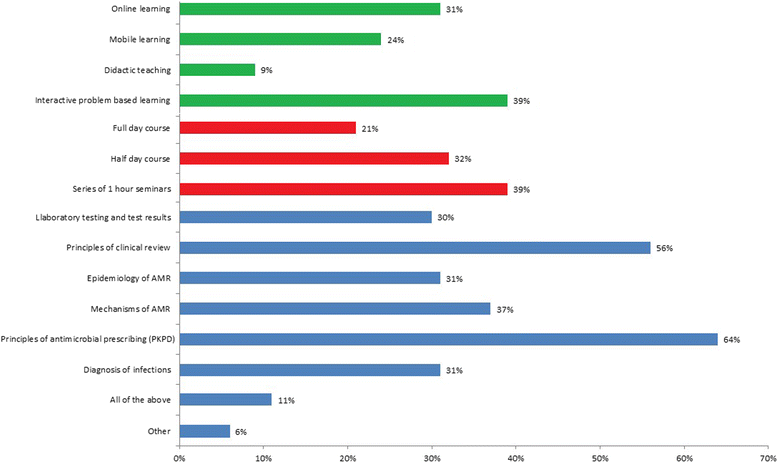A needs assessment study for optimising prescribing practice in secondary care junior doctors: the Antibiotic Prescribing Education among Doctors (APED)
- PMID: 27576784
- PMCID: PMC5006515
- DOI: 10.1186/s12879-016-1800-z
A needs assessment study for optimising prescribing practice in secondary care junior doctors: the Antibiotic Prescribing Education among Doctors (APED)
Abstract
Background: Appropriate antimicrobial prescribing is essential for patient care, yet up to half of antimicrobial prescriptions written in the UK are sub-optimal. Improving prescriber education has recently been promoted as a mechanism to optimise antimicrobial use, but identification of key learning objectives to facilitate this is so far lacking. Using qualitative methods we investigated junior doctor knowledge, attitudes, and behaviours around antimicrobial prescribing to identify key areas to address in future educational programmes.
Methods: A cross-sectional survey of qualified doctors in training in West London was undertaken exploring antimicrobial prescribing practices and educational needs.
Results: Among 140 junior doctors from 5 London hospitals, a third (34 %) reported prescribing primarily unsupervised, and two thirds (67 %) reported difficulties obtaining prescribing support outside of hours. 20 % stated not feeling confident in writing an antimicrobial prescription, but confidence was increased through having confirmatory diagnostic results (24) and obtaining advice from a senior doctor (26 %); whether this senior was from their own specialty, or an infection-specialist, varied significantly (p < 0.01) by experience. Only a small percentage (5-13 %; depending on number of years post-qualification) of participants stated their previous antimicrobial education was effective. 60 % of those in their first year post qualification reported wanting further education in antimicrobial prescribing, rising to 74 % among more experienced junior doctors. Specific areas of educational need identified were (i) principles of antimicrobial prescribing, (ii) diagnosis of infections, (iii) clinical review of patients with infections, (iv) prescribing in the context of antimicrobial resistance, and (v) laboratory testing and test results.
Conclusions: A significant proportion of junior doctors report lone prescribing of antimicrobials in the context of low self-perceived confidence and knowledge in this field, and frequent difficulty in accessing help when necessary. Innovative training, targeting five specific areas identified through this needs assessment, is urgently needed by junior doctors practising in secondary care.
Keywords: Antimicrobials; Behaviour; Clinical education; Continuing medical education; Knowledge.
Figures


Similar articles
-
Knowledge, attitudes and practice preference regarding drug prescriptions of resident dental doctors: A quantitative study.Int J Risk Saf Med. 2019;30(2):91-100. doi: 10.3233/JRS-180021. Int J Risk Saf Med. 2019. PMID: 31256074
-
Essential diseases in prescribing: A national Delphi study towards a core curriculum in pharmacotherapy education.Br J Clin Pharmacol. 2018 Nov;84(11):2645-2650. doi: 10.1111/bcp.13730. Epub 2018 Sep 6. Br J Clin Pharmacol. 2018. PMID: 30076631 Free PMC article.
-
A window into the lives of junior doctors: narrative interviews exploring antimicrobial prescribing experiences.J Antimicrob Chemother. 2014 Aug;69(8):2274-83. doi: 10.1093/jac/dku093. Epub 2014 Apr 3. J Antimicrob Chemother. 2014. PMID: 24699710
-
Improving feedback on junior doctors' prescribing errors: mixed-methods evaluation of a quality improvement project.BMJ Qual Saf. 2017 Mar;26(3):240-247. doi: 10.1136/bmjqs-2015-004717. Epub 2016 Apr 4. BMJ Qual Saf. 2017. PMID: 27044881 Free PMC article. Review.
-
Social and professional influences on antimicrobial prescribing for doctors-in-training: a realist review.J Antimicrob Chemother. 2017 Sep 1;72(9):2418-2430. doi: 10.1093/jac/dkx194. J Antimicrob Chemother. 2017. PMID: 28859445 Free PMC article. Review.
Cited by
-
Pharmacists' Knowledge, Attitudes, Behaviors and Information Sources on Antibiotic Use and Resistance in Jordan.Antibiotics (Basel). 2022 Jan 28;11(2):175. doi: 10.3390/antibiotics11020175. Antibiotics (Basel). 2022. PMID: 35203777 Free PMC article.
-
Awareness Regarding Antimicrobial Resistance and Antibiotic Prescribing Behavior among Physicians: Results from a Nationwide Cross-Sectional Survey in India.Antibiotics (Basel). 2023 Sep 29;12(10):1496. doi: 10.3390/antibiotics12101496. Antibiotics (Basel). 2023. PMID: 37887197 Free PMC article.
-
Bacterial Tree of Life: assessing the efficacy of microbiology teaching for foundation year doctors.Infect Prev Pract. 2024 Jul 11;6(3):100384. doi: 10.1016/j.infpip.2024.100384. eCollection 2024 Sep. Infect Prev Pract. 2024. PMID: 39139186 Free PMC article. No abstract available.
-
Needs assessment of a pythiosis continuing professional development program.PLoS Negl Trop Dis. 2024 Feb 26;18(2):e0012004. doi: 10.1371/journal.pntd.0012004. eCollection 2024 Feb. PLoS Negl Trop Dis. 2024. PMID: 38408109 Free PMC article.
-
The knowledge and perceptions regarding antibiotic stewardship of the interns rotating at the Bloemfontein Academic Complex.S Afr Fam Pract (2004). 2021 Oct 26;63(1):e1-e6. doi: 10.4102/safp.v63i1.5336. S Afr Fam Pract (2004). 2021. PMID: 34797090 Free PMC article.
References
-
- Davey P, Brown E, Charani E, Fenelon L, Gould IM, Holmes A, Ramsay CR, Wiffen PJ, Wilcox M. Interventions to improve antibiotic prescribing practices for hospital inpatients. The Cochrane database of systematic reviews. 2013;4:CD003543. - PubMed
-
- Davies SC, Gibbens N. UK Five Year Antimicrobial Resistance Strategy 2013 to 2018. In. London: Department of Health; 2013.
-
- WHO . The evolving threat of antimicrobial resistance: Options for action. Geneva: World Health Organisation; 2012.
MeSH terms
Substances
Grants and funding
LinkOut - more resources
Full Text Sources
Other Literature Sources
Medical

